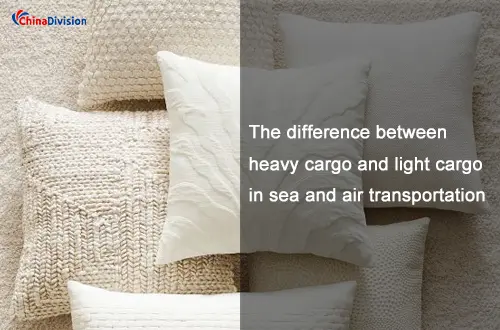Solve the Transportation Problem of Lightweight Cargo
In the field of international transportation, Lightweight Cargo is a common and highly concerned topic. It not only involves the weight and volume of goods, but also the transportation cost and efficiency. From the perspective of professional logistics service providers, this article will analyze the classification, transportation strategy and optimization plan of light cargo in combination with common pain points in the industry, to help companies reduce logistics costs and improve supply chain efficiency.
Table of Contents
What Is Lightweight Cargo?
Lightweight Cargo refers to shipments that are large in volume but low in actual weight. These are also called:
Volume Cargo
Bubble Cargo
Throwing Cargo
Goods with Large Volume but Light Weight
Common examples include: Pillows and cushions,Plastic containers,Inflatable toys,Packaging supplies,Apparel in bulk packaging.
Term Definition and Industry Confusion
Lightweight Cargo is essentially the same as Light Cargo, both referring to goods with a volumetric weight greater than the actual weight. For example, if the weight of one cubic meter of cargo is less than 167 kilograms (air transport standard) or 1 ton (sea transport standard), it is considered light cargo.

Volume Cargo and Goods with Large Volume but Light Weight are synonymous expressions for light cargo, which are commonly seen in categories such as textiles, plastic products, and electronic product accessories.
Bubble Cargo and Throwing Cargo are industry slangs that emphasize the characteristics of large volume and low density of cargo.
The difference between heavy cargo and light cargo in sea and air transport
Heavy cargo and light cargo in sea transport
Deadweight Cargo or Heavy Goods: If the weight of each cubic meter of cargo is greater than 1 ton, or the cargo stowage factor is less than the cargo volume factor of the ship, it is considered heavy cargo.
Light Cargo or Measurement Cargo: If the weight of each cubic meter of cargo is less than 1 ton, or the cargo stowage factor is greater than the cargo volume factor of the ship, it is considered light cargo.
Deadweight Cargo or Heavy Goods in Air Transport
Deadweight Cargo or Heavy Goods: If the actual weight of the goods is greater than the weight calculated by volume (volume weight = length × width × height / 6000 cm³), or the weight per 6000 cubic centimeters exceeds 1 kg, it is deadweight cargo.
Light Cargo or Measurement Cargo: If the volume weight of the goods is greater than the actual weight, the goods are light goods.
Common Hot Topics and Industry Suggestions
How to reduce the transportation cost of light goods?
Optimize packaging: Reduce unnecessary packaging materials and compress the volume of goods. For example, use vacuum compression bags to handle textiles.
Choose the right mode of transportation: Light goods prefer sea freight, which is cheaper than air freight; urgent orders can be combined with express delivery and air freight to balance timeliness and cost.
Is it feasible to match heavy goods with light goods?
Technical feasibility: Modern logistics technology has achieved accurate loading of heavy goods and light goods, such as optimizing cabin utilization through intelligent algorithms.
Economic feasibility: Reasonable matching can reduce the overall freight cost. For example, a company reduced the freight cost by 15% by mixing heavy goods and light goods in a 1:2 ratio.
How to avoid transportation disputes?
Clear billing standards: Specify the transportation method and billing rules (such as volume weight conversion coefficient) in the contract to avoid disputes caused by confusion of terms.
Choose professional service providers: Cooperate with logistics providers with international transportation experience such as Chinadivision to ensure transportation compliance and cost controllability.
Chinadivision's suggestions for solving the problem of light cargo transportation
Reasonable packaging and optimized volume
Compression packaging: Use compression technology to reduce the volume of goods, such as vacuum packaging or splitting large goods into small pieces for transportation.
Modular design: Modular design of foam goods, furniture and other items to reduce the transportation volume and weight.
Customized transportation plan
Choose the appropriate transportation method according to the characteristics of the goods, such as sea freight LCL or air freight bulk. ChinaDivision provides flexible transportation plans to help customers balance cost and timeliness.
Improve cargo protection
Use professional padding and shockproof materials to reinforce the packaging of light goods to reduce the risk of damage during transportation. ChinaDivision's logistics team can provide customized packaging solutions to ensure the safety of goods.
Optimize warehousing and distribution
Store light goods in layers, plan storage space reasonably, and improve storage efficiency. Use a distributed warehousing network to reduce delivery distances and reduce costs.
Transparent transportation process
With the help of a digital logistics management system, monitor the transportation status of goods in real time to ensure that each link goes smoothly. ChinaDivision's intelligent system can provide full tracking services, allowing customers to keep abreast of the dynamics of goods at any time.
Automatic parcel sorting
Light goods usually require large quantities of transportation. With the automatic parcel sorting system in our warehouse, we can quickly and accurately handle and dispatch light items, thereby reducing delays and mis-shipments.
Light goods have become a transportation problem for many B2B companies and e-commerce sellers due to their special transportation needs, but these problems can be effectively solved with the support of professional logistics services. By working with ChinaDivision, you can easily cope with the challenges of light goods transportation and focus on business development.
Contact ChinaDivision now and let us provide professional support for your light goods transportation and help your business grow globally!





